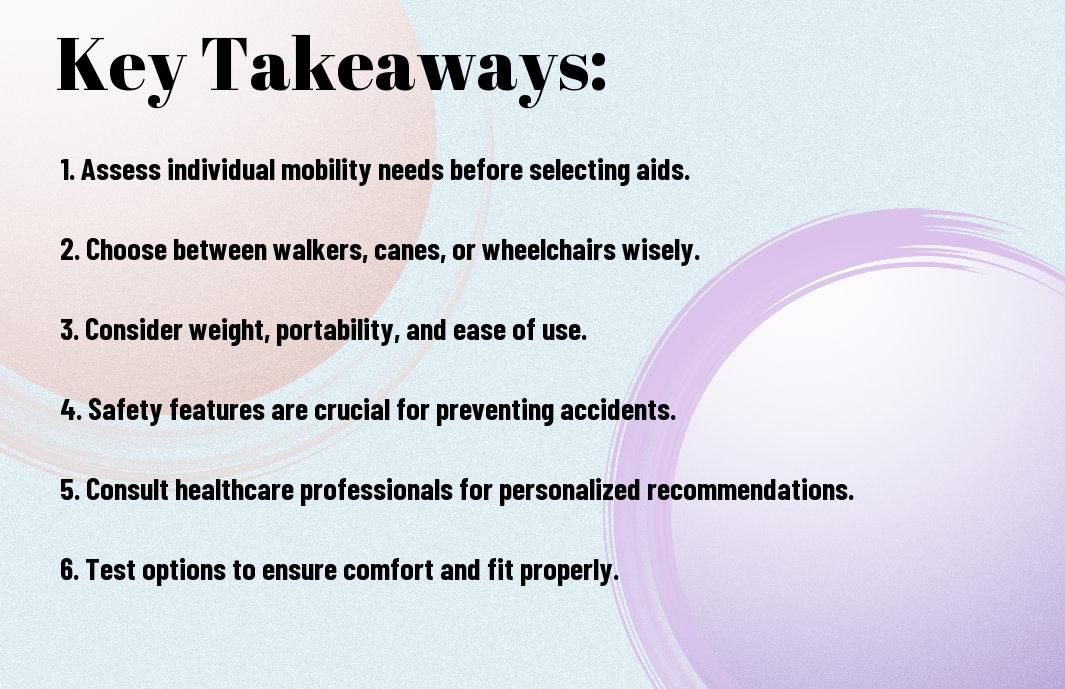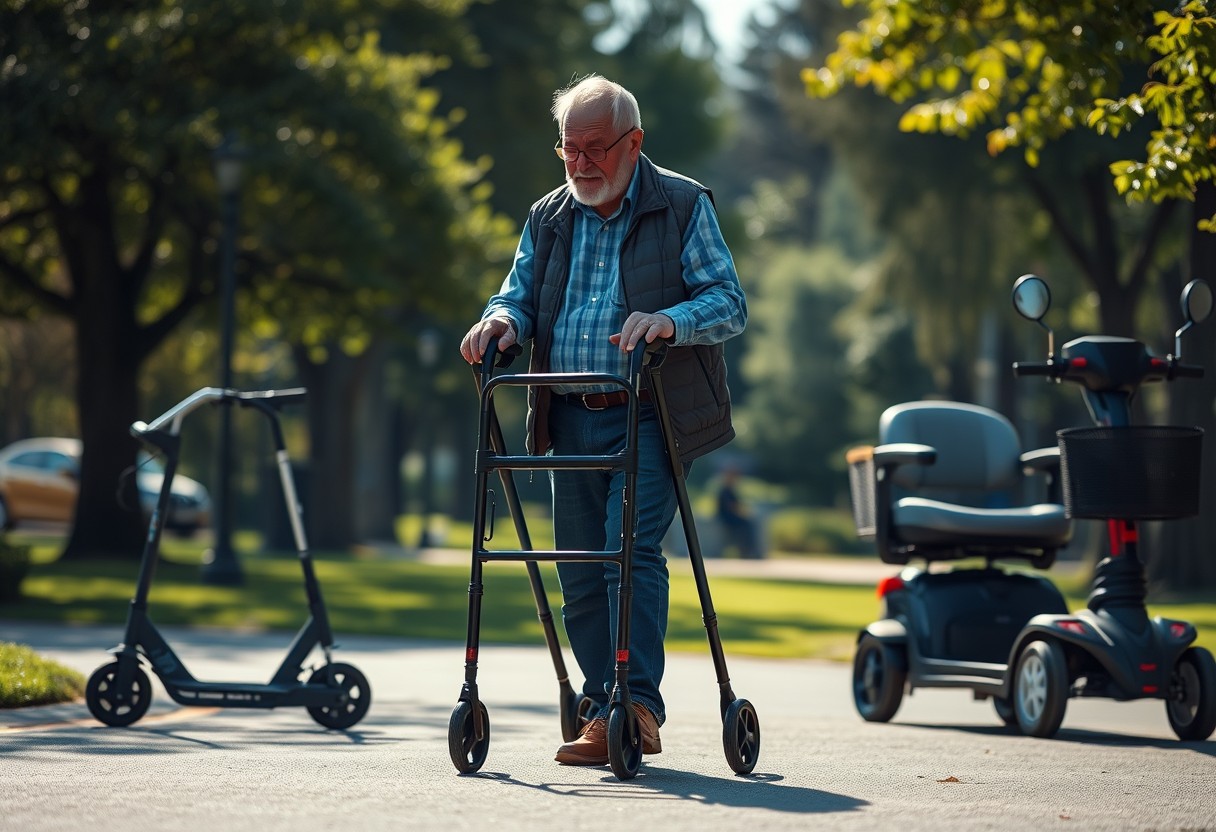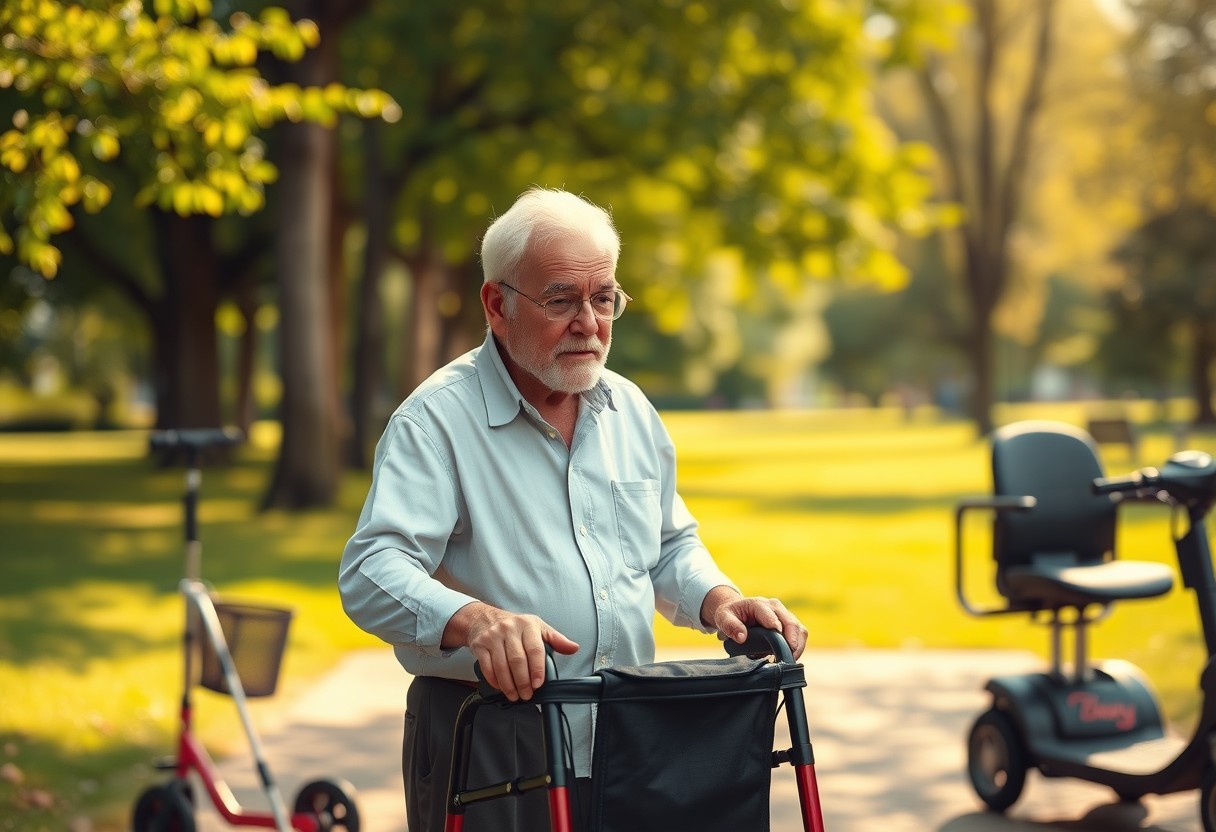It’s crucial for seniors to find the right mobility aid that enhances their freedom while ensuring their safety. With various options available, he, she, or they must consider individual needs, such as balance, strength, and lifestyle. From walkers to scooters, each type of aid serves a specific purpose and can significantly improve daily activities. Understanding the features and benefits of each mobility aid allows seniors to make informed decisions that promote independence and enhance quality of life. This guide will help explore suitable options tailored to individual requirements.
Key Takeaways:
- Individual Needs: Assessing a senior’s specific mobility challenges and lifestyle requirements is crucial for selecting the right aid.
- Types of Aids: Familiarize yourself with various options such as walkers, wheelchairs, scooters, and canes, each serving different purposes.
- Safety and Comfort: Prioritize aids that provide stability and comfort, considering features like adjustable height, weight capacity, and easy maneuverability.

Understanding Mobility Aids
While the journey of aging can bring challenges, mobility aids can vastly improve a senior’s quality of life. These aids serve to enhance independence, offering support for those with limited mobility. By understanding their purpose and types, individuals can better navigate the available options tailored to specific needs.
Types of Mobility Aids
Mobility aids come in various forms, each designed to cater to different levels of assistance required. Some common types are:
- Walkers
- Canes
- Wheelchairs
- Rollators
- Mobility scooters
After evaluating the range of options, he or she can select the right aid to regain autonomy.
| Mobility Aid | Purpose |
| Walker | Provides stability and support while walking. |
| Canes | Offers balance assistance for minimal support. |
| Wheelchair | Designed for those who cannot walk or stand. |
| Rollator | A walker with wheels for easier mobility. |
Benefits of Using Mobility Aids
For seniors, utilizing mobility aids can significantly foster a sense of freedom and confidence. By providing necessary support, these aids help maintain independence, encouraging engagement in daily activities and social interactions.
Plus, mobility aids can contribute to overall health and well-being. Reducing the risk of falls is crucial, as falls can lead to serious injuries. They also enhance endurance, allowing seniors to move around more easily and improve their fitness levels. Furthermore, a sense of security in movement helps reduce anxiety and promotes a positive attitude, empowering them to live actively and engage with their community.

Assessing Individual Needs
It is crucial to assess individual needs when selecting mobility aids for seniors, as this understanding will guide them in choosing solutions that enhance freedom and independence. Each person has unique requirements based on their physical abilities, lifestyle, and environment, which must be carefully evaluated to ensure optimal support and safety.
Evaluating Physical Limitations
On assessing physical limitations, a senior must consider their balance, strength, and range of motion. These factors greatly influence the type of mobility aid suitable for them, whether it be a cane, walker, or wheelchair, ensuring they choose a device that maintains their stability while encouraging mobility.
Lifestyle Considerations
On understanding lifestyle considerations, it is vital to evaluate how daily routines and social activities impact the choice of mobility aids. Factors like living arrangements, community engagement, and personal preferences help determine the best option for facilitating mobility without compromising comfort and ease of use.
The key to selecting the right mobility aid lies in recognizing the senior’s daily activities and the environment they navigate. For instance, those who frequently engage in social outings may benefit more from lightweight and portable aids, whereas individuals who primarily stay indoors might require more stable options that support longer usage periods. Additionally, considering personal style and comfort can significantly enhance their experience, making them feel confident and empowered in their mobility choices.
Popular Mobility Aid Options
Keep in mind that selecting the right mobility aid can greatly enhance a senior’s independence and quality of life. Various options are available, each designed to meet different needs and preferences, ensuring seniors can navigate their environments safely and confidently.
Walkers and Rollators
Any senior considering mobility aids will find that walkers and rollators provide excellent support for those who need assistance balancing. Walkers typically offer stability with minimal features, while rollators come with wheels and storage options, making them ideal for those who may need to sit occasionally during their outings.
Wheelchairs and Scooters
Popular among seniors who require more substantial mobility assistance, wheelchairs and scooters offer varying degrees of independence. They are especially beneficial for seniors with limited upper body strength or those who fatigue easily. The main advantages of these mobility aids include increased maneuverability and the ability to travel longer distances effortlessly. However, proper training in usage is crucial as improper handling can lead to accidents. Regular maintenance is also necessary to ensure they remain in safe and working condition, allowing seniors to maintain their freedom while navigating complex environments.
Safety Features to Consider
Not all mobility aids are created equal regarding safety features. Seniors should prioritize options that come equipped with crucial elements such as anti-tip designs, handbrakes, and non-slip surfaces. These features can significantly enhance their overall security while providing the independence they seek. They should also examine the weight capacity and the ease of control to ensure they choose a mobility aid that accommodates their specific needs and capabilities.
Stability and Durability
Safety begins with ensuring that the mobility aid offers outstanding stability and durability. A sturdy frame can significantly reduce the risk of accidents, and it is critical that the aid can withstand the wear and tear of daily use. Seniors should consider evaluating user reviews and product specifications to determine the reliability of the equipment before making a purchase.
User-Friendly Design
On top of safety features, a user-friendly design plays a crucial role in a senior’s overall experience with mobility aids. An intuitive design promotes both comfort and independence, as it allows them to easily navigate their environment without struggle. Features like adjustable heights, lightweight materials, and simple folding mechanisms can make a considerable difference in usability.
With a user-friendly design, mobility aids allow seniors to regain their freedom while ensuring usability and comfort. They should seek aids with easy-to-operate controls and lightweight materials, enabling them to maneuver effortlessly. Additionally, options that come with padded grips can enhance grip security and reduce hand strain, while collapsible designs facilitate storage and transportation. Such thoughtful features ultimately empower seniors to maintain their independence and confidence as they navigate their daily activities.
Financial Considerations
Despite the importance of mobility aids in enhancing independence, seniors often face financial challenges when acquiring them. The cost of these devices can vary significantly, which necessitates careful planning to ensure that they choose an option that meets their needs while staying within budget. Exploring various financing options is crucial for making informed decisions about mobility aids.
Budgeting for Mobility Aids
Aids should be approached as a key investment in one’s quality of life. Seniors must consider their overall financial situation, prioritize imperative features, and research multiple brands and models to find a balance between affordability and functionality. Establishing a clear budget can prevent overspending while ensuring that the chosen mobility aid meets their daily needs.
Insurance and Financial Assistance
Considerations for insurance coverage and potential financial assistance can significantly alleviate the burden of purchasing mobility aids. Many seniors may qualify for coverage through Medicare, Medicaid, or private insurance plans, which can help cover the costs of imperative devices. Additionally, organizations and non-profits may offer financial aid or discounts, and some companies provide payment plans. It is vital for them to research their options and understand the specifics of their coverage to maximize available benefits.
Financial assistance is crucial for seniors who may struggle with the costs associated with mobility aids. Many health insurance plans, including Medicare, offer coverage for certain items, such as wheelchairs and walkers, making it imperative for them to investigate what is included. Additionally, financial resources such as community organizations, government programs, and non-profits can provide further support, potentially covering costs or offering payment plans. By examining these opportunities, individuals can find ways to enhance their mobility while alleviating financial strain.
Resources for Assistance
Unlike common misconceptions, many resources are available to help seniors navigate their choices in mobility aids. From specialized online platforms to local support groups, families can find valuable information and assistance in making informed decisions. One such resource can be found in the Mobility Aids For Seniors: A Comprehensive Guide.
Professional Evaluations
To ensure seniors select the most suitable mobility aid, obtaining a professional evaluation from a healthcare provider is crucial. This evaluation assesses the individual’s mobility needs, physical capabilities, and overall health, guiding them toward the right product.
Community Programs
An abundance of community programs exists that provide support and resources for seniors seeking mobility assistance. These programs often offer free workshops, consultations, and even trial periods for different mobility aids, enabling seniors to experience tools that enhance their independence.
Understanding the variety of community programs available can significantly impact seniors’ well-being. Many local organizations prioritize senior health and safety by providing informative workshops on mobility aids. Additionally, they may offer networking opportunities to connect with other users, sharing experiences and insights. Accessing these programs can empower seniors to make informed decisions, improve their mobility, and ultimately enhance their quality of life.
Final Words
On the whole, selecting the right mobility aids for seniors can significantly enhance their freedom and independence. She, he, or they should consider various factors, such as individual needs, lifestyle, and physical abilities, when making their choice. Options like walkers, scooters, and wheelchairs each provide unique benefits that can cater to different requirements. To explore more about how to regain independence and mobility, they can visit Regain Your Freedom with Elderly Mobility Aids for valuable insights and assistance.
Q: What are the different types of mobility aids available for seniors?
A: There are several types of mobility aids designed to enhance freedom and independence for seniors. Common options include:
- Canes: Lightweight, portable aids that provide support for balance and stability.
- Walkers: Sturdy frames that offer greater support and stability, ideal for those who need assistance walking.
- Rollators: Walkers with wheels that allow for easier movement and often include a seat for resting.
- Wheelchairs: A seated mobility solution for individuals with limited mobility; available in manual and electric forms.
- Scooters: Motorized vehicles designed for individuals who have difficulty walking long distances, providing a convenient mode of transport.
Choosing the right aid depends on individual mobility needs, physical capabilities, and lifestyle preferences.
Q: How do I determine the best mobility aid for my needs?
A: Determining the best mobility aid involves assessing various factors, including:
- Mobility Level: Evaluate how much assistance you need based on your strength, balance, and coordination.
- Environment: Consider where the aid will be used—indoor vs. outdoor settings may require different designs.
- Comfort: Ensure the chosen aid feels comfortable and is adjustable to your height and reach.
- Safety Features: Look for aids with additional features such as brakes, stability options, and lightweight materials for ease of use.
Consulting with a healthcare professional or physiotherapist can provide valuable insights tailored to your specific situation.
Q: Are there any financial assistance options or programs available for purchasing mobility aids?
A: Yes, various financial assistance options and programs exist to help seniors purchase mobility aids. These may include:
- Medicare: Medicare may cover some mobility devices if deemed medically necessary; check your specific plan details.
- Medicaid: Depending on state regulations, Medicaid may help pay for mobility aids for eligible seniors.
- Veterans Affairs: Veterans may qualify for assistance through the VA for mobility aids; contact your local VA office for information.
- Non-Profit Organizations: Some non-profits offer grants or donation programs for mobility aids to support seniors in need.
- Community Resources: Local agencies or senior centers may have programs or partnerships to assist with mobility aid costs.
It’s advisable to research and reach out to these organizations to understand the available options and eligibility criteria.

